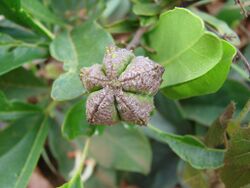Biology:Esenbeckia (plant)
From HandWiki
Short description: Genus of flowering plants
| Esenbeckia | |
|---|---|

| |
| Esenbeckia pumila | |
| Scientific classification | |
| Kingdom: | Plantae
|
| (unranked): | |
| (unranked): | |
| (unranked): | |
| Order: | |
| Family: | |
| Subfamily: | |
| Tribe: | Cusparieae
|
| Genus: | Esenbeckia Kunth[1]
|
| Type species | |
| Esenbeckia pilocarpoides Kunth[2]
| |
| Species | |
|
See text | |
Esenbeckia is a genus of flowering plants in the rue family, Rutaceae.[1] All species in the genus are native to the Americas, with the highest diversity in South America.[3] They are commonly known as jopoy,[4] the Mayan word for E. berlandieri,[5][6] or gasparillo (Spanish).[4]
Taxonomy
The generic name commemorates Germany naturalist Christian Gottfried Daniel Nees von Esenbeck (1776 - 1858).[3] The Takhtajan system places the genus in the subfamily Rutoideae, tribe Cusparieae,[7] while Germplasm Resources Information Network places it in the subfamily Toddalioideae, tribe Cusparieae.[1]
Selected species
- Esenbeckia alata (H.Karst. & Triana) Triana & Planch. — Winged Esenbeckia, Coya, Cuala-cuala (Colombia)[4]
- Esenbeckia berlandieri Baill. ex Hemsl. — Berlandier Esenbeckia, Hueso de Tigre, Limonillo (Mexico, Central America)[4]
- Esenbeckia flava Brandegee — Yellow Esenbeckia, Palo Amarillo, Palo Morio (Baja California Sur, Mexico)[4]
- Esenbeckia grandiflora Mart.
- Esenbeckia hartmanii B.L.Rob. & Fernald — Hartman Esenbeckia, Crucecilla, Sámota (Sonora and Sinaloa, Mexico)[4]
- Esenbeckia leiocarpa Engl. (Atlantic moist forests, Brazil )
- Esenbeckia pilocarpoides Kunth
- Esenbeckia pumila Pohl
- Esenbeckia runyonii C.V.Morton — Runyon's Esenbeckia, Limoncillo (Sierra Madre Oriental in northeastern Mexico, Rio Grande Valley of Texas in the United States )[8]
Formerly placed here
- Balfourodendron riedelianum (Engl.) Engl. (as E. riedeliana Engl.)[9]
References
- ↑ 1.0 1.1 1.2 "Esenbeckia Kunth". Germplasm Resources Information Network. United States Department of Agriculture. 2008-03-20. http://www.ars-grin.gov/cgi-bin/npgs/html/genus.pl?4461. Retrieved 2010-06-21.
- ↑ "Esenbeckia Kunth". TROPICOS. Missouri Botanical Garden. http://www.tropicos.org/NameDetails.aspx?nameid=40006221. Retrieved 2010-01-09.
- ↑ 3.0 3.1 Everett, Thomas H. (1981). The New York Botanical Garden Illustrated Encyclopedia of Horticulture. 4. Courier Corporation. p. 1268. ISBN 978-0-8240-7234-6. https://books.google.com/books?id=h6xcnf5TksYC.
- ↑ 4.0 4.1 4.2 4.3 4.4 4.5 Grandtner, Miroslav M. (2005). Elsevier's Dictionary of Trees: With Names in Latin, English, French, Spanish and Other Languages. 1. Elsevier. pp. 335–336. ISBN 978-0-444-51784-5. https://books.google.com/books?id=yjc5ZYWtkNAC.
- ↑ Nokes, Jill (2001). How to Grow Native Plants of Texas and the Southwest (2 ed.). University of Texas Press. p. 261. ISBN 978-0-292-75573-4. https://books.google.com/books?id=r9qqlxIOKTwC&dq.
- ↑ Jopoy is also the word for Ficus spp. in Teenek (Wastek language), see Alcorn, Janis B. (1984). Huastec Mayan Ethnobotany. University of Texas Press. p. 653. ISBN 978-0-292-71543-1. https://books.google.com/books?id=cblVAAAAMAAJ.
- ↑ Takhtajan, Armen (2009). Flowering Plants (2 ed.). Springer. p. 375. ISBN 9781402096082. https://books.google.com/books?id=oumyfO-NHuUC&.
- ↑ "Esenbeckia Kunth Subordinate Taxa". TROPICOS. Missouri Botanical Garden. http://www.tropicos.org/NameSubordinateTaxa.aspx?nameid=40006221. Retrieved 2010-01-10.
- ↑ "GRIN Species Records of Esenbeckia". Germplasm Resources Information Network. United States Department of Agriculture. http://www.ars-grin.gov/cgi-bin/npgs/html/splist.pl?4461. Retrieved 2010-09-16.
Wikidata ☰ Q3280428 entry

